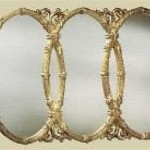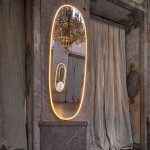Hanging Heavy Mirrors On Plasterboard Walls
Plasterboard walls, also known as drywall, are a common feature in modern construction due to their cost-effectiveness and ease of installation. However, their composition presents a challenge when it comes to hanging heavy objects, such as mirrors. Unlike solid wood or concrete walls, plasterboard lacks the inherent structural strength to support significant weight on its own. Successfully mounting a heavy mirror on a plasterboard wall requires careful planning, the right tools, and a thorough understanding of available techniques. Failure to properly install a heavy mirror can result in damage to the wall, the mirror itself, and potentially even personal injury.
This article provides a comprehensive guide to securely hanging heavy mirrors on plasterboard walls. It will cover essential considerations, available hardware options, and step-by-step instructions to ensure a safe and aesthetically pleasing installation. It is crucial to prioritize safety and adhere to best practices outlined here.
Identifying Wall Type and Assessing Weight
Before attempting to hang a heavy mirror, accurately determining the wall type is paramount. While this article focuses on plasterboard walls, other wall types such as brick, concrete, or wood paneling require entirely different approaches. A simple test involves gently tapping on the wall's surface. Plasterboard typically produces a hollow sound, while solid walls like brick or concrete will sound significantly more dense. If uncertainty persists, checking behind electrical outlets or light switch covers can provide a definitive confirmation of the wall's composition. Exercise extreme caution when removing electrical covers, ensuring the power is switched off at the breaker to avoid electrical shock.
Once the wall type is confirmed as plasterboard, assess the mirror's weight. This information is usually available on the product packaging or from the manufacturer. If the weight is not readily available, using a bathroom scale to weigh the mirror is a suitable alternative. Knowing the precise weight allows for selecting appropriate hardware and installation methods. Guessing the weight can lead to using inadequate support, resulting in failure and potential damage.
Consider also the mirror's dimensions. A large, heavy mirror will exert more leverage on the wall than a smaller one of the same weight. This leverage increases the strain on the mounting hardware and the plasterboard itself. Therefore, larger mirrors often require more robust anchoring solutions and potentially additional support.
Selecting Appropriate Hardware
The choice of hardware is critical for securely hanging a heavy mirror on a plasterboard wall. Standard nails are completely unsuitable, as they provide minimal holding power in plasterboard. Specialized anchors designed for plasterboard are necessary to distribute the weight and prevent the mirror from pulling away from the wall.
Several types of plasterboard anchors are available, each with varying weight capacities and installation requirements. The most common types include:
- Hollow Wall Anchors (Molly Bolts): These anchors provide a strong and reliable hold in plasterboard. They consist of a metal sleeve that expands behind the wall as the screw is tightened, creating a secure grip. Molly bolts are suitable for heavier mirrors and are relatively easy to install.
- Toggle Bolts: Toggle bolts offer excellent holding power and are ideal for very heavy mirrors. They consist of a bolt with spring-loaded wings that fold flat for insertion into the wall. Once inside, the wings spring open, creating a wide bearing surface behind the plasterboard.
- Self-Drilling Anchors (Wall Plugs): These anchors are designed for lighter loads and are easy to install. They typically have a pointed tip that allows them to be screwed directly into the plasterboard without pre-drilling. While convenient, their weight capacity is generally limited.
- Heavy-Duty Picture Hanging Hooks: Some specialized picture hanging hooks are designed for plasterboard and claim to hold substantial weight. These hooks often utilize multiple small nails angled into the wall to distribute the load. However, their reliability can vary, and it is essential to choose a reputable brand and carefully consider the weight rating.
When selecting anchors, carefully consider the mirror's weight and the anchor's weight capacity. Always choose anchors with a weight rating that significantly exceeds the mirror's weight to provide a margin of safety. Consult the anchor manufacturer's specifications for detailed information on weight capacity and installation instructions. Overestimating the required weight capacity is always preferable to underestimating it.
In addition to anchors, choose appropriate screws or bolts to work with the selected anchors. The screws or bolts should be long enough to pass through the mirror's hanging hardware and extend sufficiently into the anchor to ensure a secure connection. Using undersized screws or bolts can compromise the anchor's holding power.
Step-by-Step Installation Guide
Following a systematic installation process is essential for achieving a secure and stable mirror mounting. This section provides a detailed, step-by-step guide for hanging a heavy mirror on a plasterboard wall, assuming the appropriate hardware has been selected based on the mirror's weight and dimensions.
- Preparation: Gather all necessary tools and materials, including the mirror, anchors, screws/bolts, a drill (if required), a screwdriver, a level, a tape measure, a pencil, and safety glasses. Protect the floor beneath the work area with a drop cloth or similar covering to prevent damage.
- Locate Wall Studs (Optional): If possible, locating and utilizing wall studs provides the strongest possible support. Studs are vertical wooden beams within the wall that offer significantly greater holding power than plasterboard alone. A stud finder can be used to locate studs behind the plasterboard. If a stud is found in the desired location, using screws directly into the stud is the ideal solution. If no stud is accessible, proceed with using plasterboard anchors.
- Mark Anchor Locations: Use a tape measure and level to determine the desired location for the mirror. Mark the positions for the anchors on the wall with a pencil. Ensure the marks are level and evenly spaced to distribute the weight properly. Accurate measurements are crucial for achieving a visually appealing and stable installation.
- Drill Pilot Holes (If Required): If using self-drilling anchors or hollow wall anchors that require pre-drilling, use a drill with the appropriate size drill bit to create pilot holes at the marked locations. The drill bit size should match the anchor manufacturer's recommendations. Drilling straight and applying gentle pressure will prevent damaging the plasterboard.
- Install Anchors: Insert the anchors into the pilot holes (if drilled) or directly into the plasterboard (for self-drilling anchors). Follow the anchor manufacturer's instructions for proper installation. For hollow wall anchors, ensure the metal sleeve is fully expanded behind the wall. For toggle bolts, fold the wings flat, insert the bolt through the mirror's hanging hardware, and then push the bolt and wings through the hole in the wall. Once the wings are inside the wall, they will spring open.
- Mount the Mirror: Carefully align the mirror with the installed anchors. Insert the screws or bolts through the mirror's hanging hardware and into the anchors. Tighten the screws or bolts until the mirror is securely attached to the wall. Avoid overtightening, which can damage the plasterboard or the mirror.
- Check for Stability: Once the mirror is mounted, gently test its stability by applying slight pressure to different areas. The mirror should feel secure and stable, with no excessive movement or wobbling. If any instability is detected, re-evaluate the anchor selection or tighten the screws/bolts further (without overtightening).
Throughout the installation process, prioritize safety. Wear safety glasses to protect the eyes from debris. Use caution when handling power tools. If unsure about any step, consult a professional handyman or contractor.
Alternative Support Methods
While the above method focuses on using anchors directly in the plasterboard, alternative support methods can further enhance the stability and safety of hanging heavy mirrors. These methods are particularly useful for very large or exceptionally heavy mirrors.
French Cleats: A French cleat is a simple and effective way to distribute the weight of a heavy object across a wider area of the wall. It consists of two interlocking pieces of wood, one attached to the back of the mirror and the other attached to the wall. The angled design of the cleats allows the mirror to hang securely and distribute the weight evenly. The wall-mounted cleat can be attached to multiple wall studs for maximum support, even if those studs aren't in the ideal position for hanging the mirror.
Vertical Supports: For very large mirrors, consider adding vertical supports that extend from the floor to the bottom of the mirror. These supports can be made from wood or metal and provide additional stability by bearing some of the mirror's weight. The supports can be discreetly designed to blend seamlessly with the mirror's frame or the surrounding decor.
Professional Installation: If the mirror is exceptionally heavy or valuable, or if any uncertainty exists regarding the installation process, it is always advisable to hire a professional handyman or contractor. Professionals possess the experience, tools, and expertise to ensure a safe and secure installation, minimizing the risk of damage or injury.
By implementing these techniques and carefully considering the information provided, hanging heavy mirrors on plasterboard walls can be accomplished safely and effectively. Remember that proper planning, the right tools, and a commitment to following best practices are essential for achieving a successful and long-lasting installation.

Hanging Heavy Mirror On Plaster Walls 6 Steps With Pictures Instructables

How To Hang A Heavy Mirror On Plasterboard Timber Framed Wall

How To Hang A Very Heavy Picture Or Mirror The Best
How To Hang A 100 Pound Mirror On Drywall Quora

How To Hang A Large Or Heavy Mirror

How To Hang A Heavy Mirror Without Nails S Or Drilling Velcro Brand

How To Hang A Heavy Mirror With Pictures Wikihow

Hanging A Mirror On Plasterboard Wall Howto

How To Hang A Mirror On Plasterboard Wall Soraya Interiors

Hang A Mirror On Plasterboard Wall Soraya Interiors








